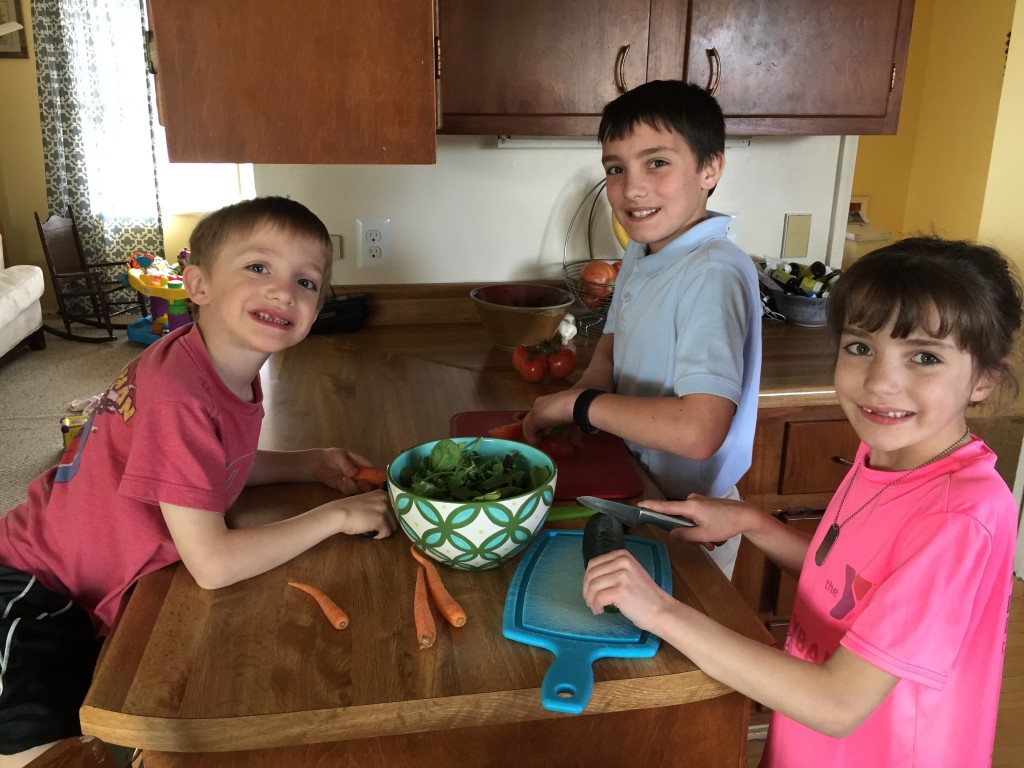Changing Your Plate Part V: Dinner
April 26, 2016
We’ve had quite a few weeks now of meeting real families from my practice who are each, in their own way, making efforts to eat more plants daily. From the Sherman family in Houston who decided to take their first steps based on their baby daughter’s milk sensitivity, to the Thorntons who wanted to get their energy back and set a good example for their young daughter, and then the Kearleys who, after several years, had some excellent tried and true tips to share. It’s been quite a journey. Now, to close out this series, I’d like to introduce you to the Lachere family of Helena, Montana.
Mom, Molly, came to me requesting help to heal her digestive tract from damage that had occurred over the years leading to a Crohns diagnose. She had tried many different routes but nothing seemed to work. When we began our work she was faced with a lifetime of heavy duty medications or some radical dietary changes. You are going to love her story!
Molly and, husband, Gerald are in their thirties. She teaches and coaches part time at a private school and Gerald is a policeman. Although she and her husband do love to cook together when they get a chance, it’s Molly who does the majority of the shopping and the cooking for their family of seven. They are proud parents to Kevin 11, Carly 8, Tyler 6, Marcella 3, and Annaleise who is soon to be 1.

When Molly and I met for her first remote appointment I was quite blunt. At this point in time, given the progression of her symptoms, if she wanted to avoid further dependency on medications she would have to get serious. And by serious she would have to at a minimum eliminate all dairy and all gluten. Even after that we would have to see what still may cause inflammation. The only way to be sure of what causes what reaction would be to reduce/eliminate processed food items. For a working mother who also feeds and cares for five children, making those changes would not be an easy route.
But Molly didn’t shy away. She listened, declared it wouldn’t be easy but she was opposed to filling her body with medication for the rest of her life. So she began to make changes for herself the very next day. Here’s what Molly had to say,
“After I felt so much better and noticed the huge changes to my health, I knew I had to get my family on board and completely change their eating habits.
In myself, I have noticed a complete change in my bowels. I went from over twenty bowel movements a day, to now just one or two solid bm’s. I also noticed better sleep, more energy, and even clearer thinking and emotions.”
Having followed Molly’s case, I’d like to point out this took a huge amount of dedication AND she had her share of emotional and physical setbacks when she questioned whether this was going to get her to where she wanted to be. This is often the case in highly inflamed individuals. Because inflammation will move along the pathways of the lymphatic system, pains will change and the “new symptoms” can be confusing. Continuing onward is the key and you will see that her perseverance has paid off. She recently underwent testing to check her inflammatory levels and both Molly and her doctors were astonished at her results. They applauded her commitment to her diet and encouraged Molly to continue whatever she was doing as it was truly making a difference!
Molly tells me about what she first noticed in her children with the changes to their diet.
“The change that stands out the most is no more tummy aches and constipation. My oldest son would spend 30 minutes every other day having a bm. My three year old would sit and cry that she couldn’t get her “poopy” out.
Over all, my children have had a healthy increase in appetite, and their attitude towards food has changed. The older ones especially see the correlation between what they eat and how they feel. How cool is that?”
What Molly saw in her children’s elimination patterns is not uncommon but unfortunately we are not trained to see those symptoms as problematic. Early elimination issues ARE exactly the start of chronic disease and parents need to pay attention. This is what food sensitivity looks like!
I love what Molly had to say about how she has framed this dietary shift for her children.
“We have approached this change with the attitude that we have a choice to feel so much better! When my kids want to eat something with dairy in it, I don’t freak out or tell them no, I simply ask them if it is worth it. Sometimes, they have said, “yep, totally worth it,” and without fail, either within minutes or days, depending on the child, (one experiences diarrhea while the other experiences constipation) they come around and decide that it wasn’t a good choice and they think a little longer next time they are faced with the same choice. The thing is, there are SO MANY alternatives that taste really good! This is absolutely not about depriving ourselves!”
Molly’s advice to families starting out is to take it slow and take time to make the changes.
“This is not an overnight lifestyle change,” Molly smartly shares, “every time you make a small change, you will feel better and will want to continue. The longer you are off of the dairy, the more you will notice the reaction if you try it again.”
So as Molly began implementing these changes, routines were very important. Because routines are already necessary for a family of seven, food planning would be no different. On a typical day, Molly’s husband Gerald gets up and starts the smoothies. He also makes lunches while Molly gets the kids up and moving. The big kids and dad are out the door by 7:40. Molly works part time, so if it is a work day, she gets the little ones packed up and fed and they are all ready to go by 9:15. All of the kids and Molly are home by 3:45 and dinner gets started right away. Kevin, the 11 year old, is in charge of the salad making but he often recruits the others. He is training them well! Gerald is home by 5:15 and dinner happens right away. Because the kids often have sports or meetings to attend, the Lachere family divides and conquers the evening activities.

Some routines came quite easily. Every morning without fail they all began to have their smoothies, every lunch box got two vegetables, and every dinner began with a salad. But what to do about that main course?
After all the challenges I gave to Molly it was her opportunity to turn the tables on me. Molly had this to say:
“Plant based eating is challenging for us mostly because I wasn’t raised this way and all of my go to family favorites included large amounts of cheese, milk, cream, and meat. These are the meals my kids know and love and they aren’t about to give them up without a fight! I can’t just put a bowl of raw vegetables on the table with some dipping sauce and say, dinner is served!”
I asked Molly to give me a list of “family favorites” and I would get to work on finding some similar recipes that would keep them all on their new diet AND please her kids.
The list from Molly and her kids may sound a lot like your family favorites: casseroles, lasagna, tacos, stuffed peppers, stir fry, sandwiches, and cream based soups.
Before I got carried away, Molly reminded me, “The goal is always tasty, cheap, and easy. We are a big and busy family after all!”
So I had my challenge. Molly and family agreed to test out any recipe that met their standards and give me feedback. Later this week I’ll be featuring the Lachere kids teaming up to make plant based stuffed bell peppers and you”ll see for yourself what they thought about the results!
Immunity matters!
Learn to support your health naturally with weekly tips
delivered straight to your inbox.

Love this story!!
Loved reading this and look forward to the next installment!